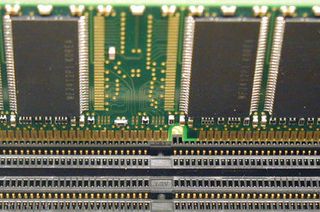Sneak Preview: Intel Alderwood/Grantsdale Chipsets
DDR2: 200 And 266 MHz To Start With

With DDR2, the contacts move closer together, since there are 240 pins, instead of 184.
As opposed to DDR memory, which was accelerated to more than 233 MHz by many manufacturers, a JEDEC specification has been in existence since September 12, 2003 for DDR2. This specification is meant to help prevent compatibility problems as much as possible, and this might be the case in practice, especially since there is enormous support for DDR2 in the IT industry and since DDR2 is viewed as the next phase in evolution from DDR memory.
DDR2 is based on the well-established Double Data Rate technology. This means that data is transferred with both the rising and falling flanks per clock cycle. Thus, clock rates of 200 MHz and 266 MHz translate to DDR2 400 and DDR2 533 in marketing-speak. The next levels would be DDR2 667 and DDR2 800, but these are not to be expected this year.
Among the new technical features of DDR2 are the new signal terminations directly on the memory (ODT - On Die Termination), reduced page sizes (requires less power for activation) and fixed burst lengths of four and eight cycles. In the case of the latter, the specification provides for a new burst type called Sequential Nibble, which divides the burst into two 4 bit Nibbles. This also enables burst lengths of eight cycles in interleaving mode because each new column of the memory matrix can still be used with the new 4 bit prefetch.
Posted CAS makes it possible to carry out a CAS command directly after the RAS signal without any collisions. This simplifies the design of the controller and increases the theoretical load that the memory can handle.
Further differences between DDR and DDR2 are found in the details: instead of the TSO (Thin Small Outline) packages, only the FBGA (Fine-Line Ball Grid Array) casing is used. In addition to shorter circuits and reduced signal noise, FBGA has the advantage of being much more compact in size, which allows for higher memory densities. Another difference is that DDR2 DIMMs work with 1.8 V instead of the 2.5 V of DDR - this minimizes loss in performance and enables higher clock rates in the mid-term.


In terms of width, a DDR1 module fits in the 240 pin DDR2 socket, but the position of the notch is different.
Stay On the Cutting Edge: Get the Tom's Hardware Newsletter
Join the experts who read Tom's Hardware for the inside track on enthusiast PC tech news — and have for over 25 years. We'll send breaking news and in-depth reviews of CPUs, GPUs, AI, maker hardware and more straight to your inbox.
Current page: DDR2: 200 And 266 MHz To Start With
Prev Page Cooling The Core Components Via Thermal Module Next Page DDR2 Latency TimesMost Popular



